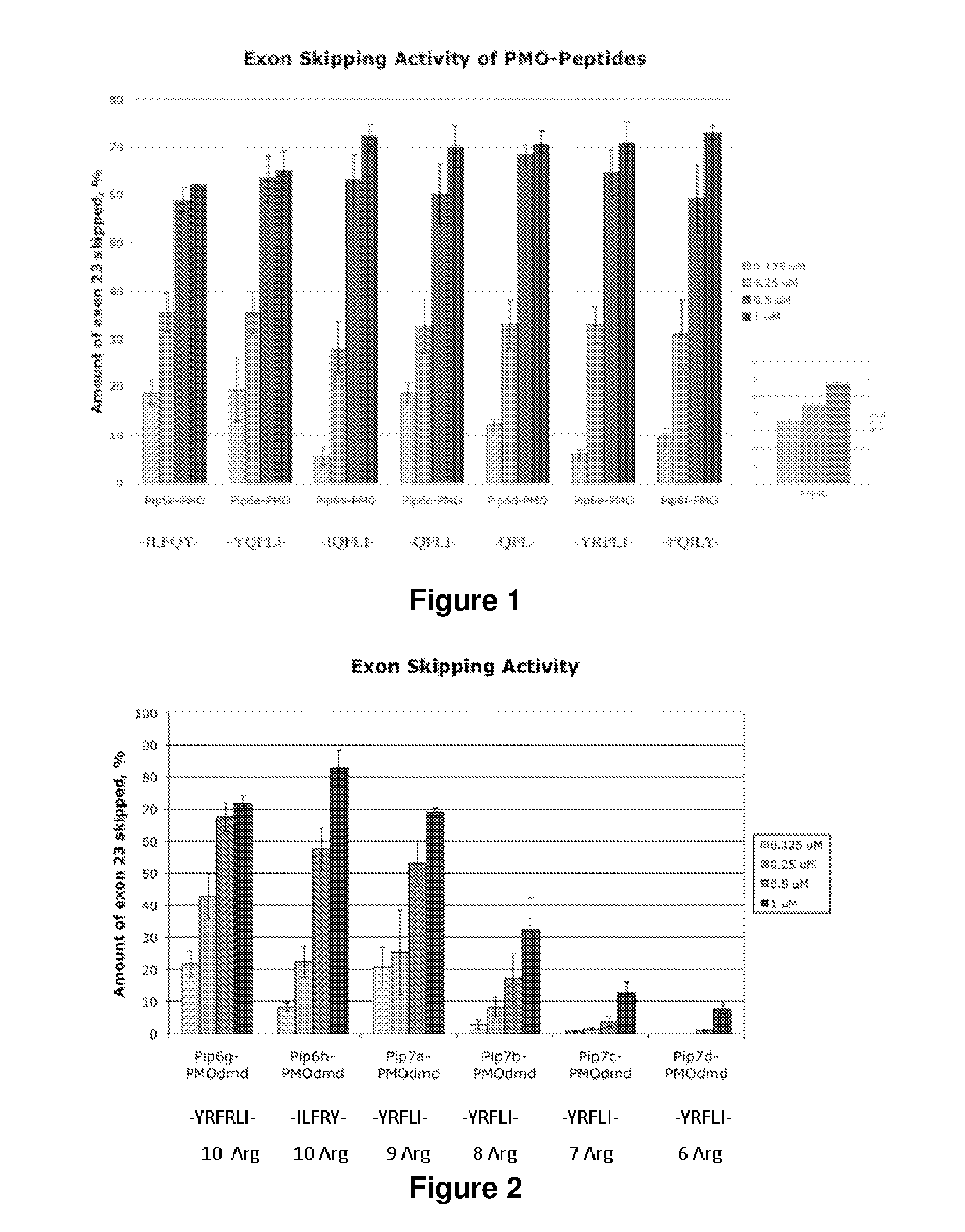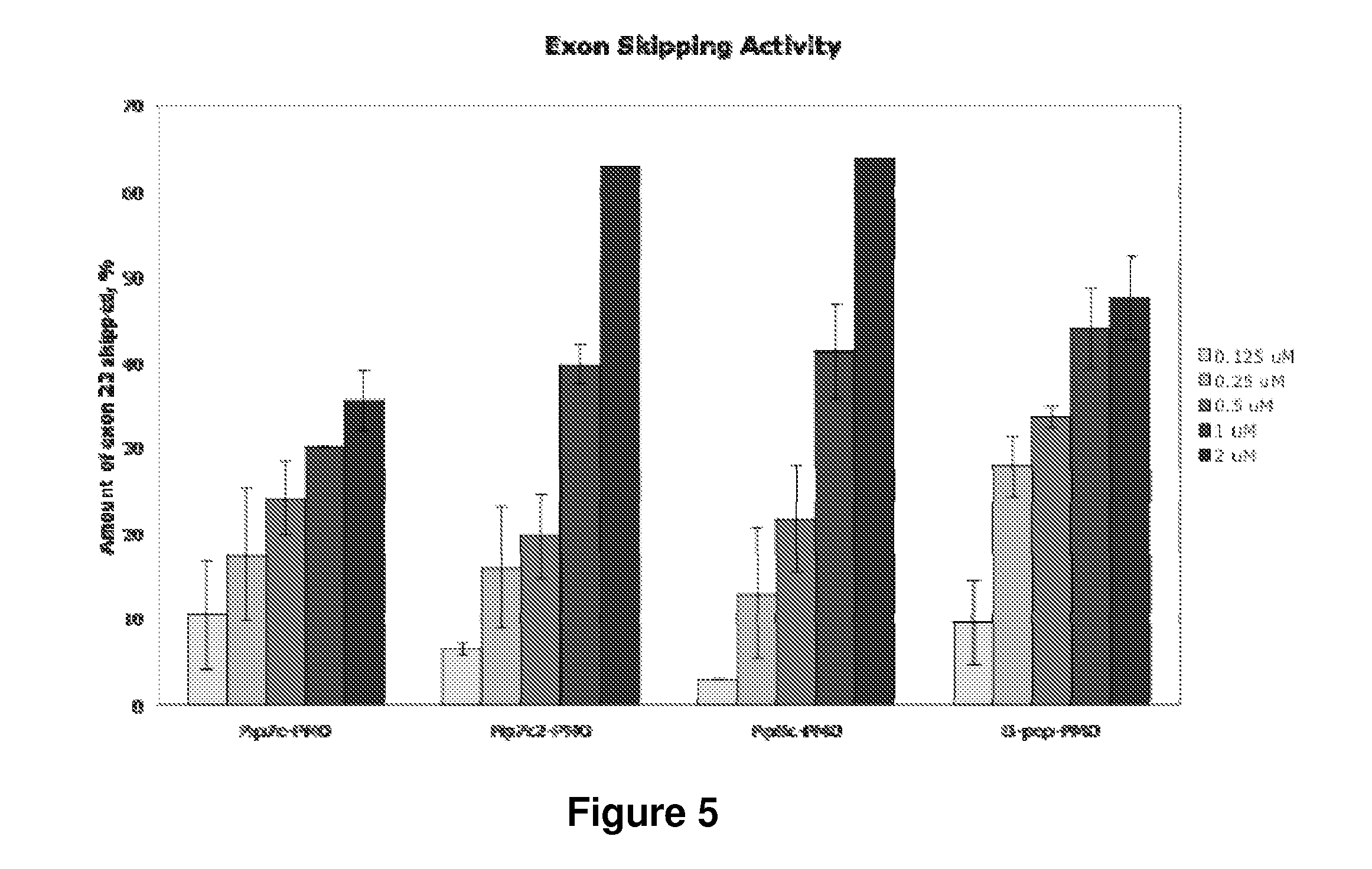Cell-Penetrating Peptides Having a Central Hydrophobic Domain
a technology of peptides and hydrophobic domains, applied in the field of peptides, can solve the problems of poor systemic antisense oligonucleotide delivery, poor cell penetration of pna and pmo, and inefficient dystrophin correction in affected non-skeletal muscle tissues, etc., to achieve the effect of increasing cell viability and resistance to degradation
- Summary
- Abstract
- Description
- Claims
- Application Information
AI Technical Summary
Benefits of technology
Problems solved by technology
Method used
Image
Examples
example 1
[0194]We have previously reported impressive heart activity including high splicing efficiency and dystrophin restoration following a single administration of an arginine-rich cell-penetrating peptide conjugated to a phosphorodiamidate morpholino oligonucleotide: Pip5e-PMO. However, the mechanisms underlying this activity are poorly understood.
[0195]Here, we report the results of studies involving single dose administration (12.5 mg / kg) of a series of derivatives of Pip5e-PMO, consecutively assigned as Pip6-PMOs, containing mutations to the hydrophobic core region of the Pip5e peptide, where this central core region amino acid sequence is reversed, scrambled or partially deleted. These changes affect the levels of exon skipping and dystrophin restoration in multiple muscle groups, including the heart, following a single, low dose intravenous injection of the corresponding Pip6-PMO conjugates. The results show that a core length of 5 amino acids (5-aa) appears to be essential for hea...
example 2
Synthesis of Peptide-PMO Conjugates
[0247]The PMO sequence (5′-GGCCAAACCTCGGCTTACCTGAAAT-3′) [SEQ ID NO:310] was purchased from Gene Tools, LLC. Peptides were synthesized in house by standard 9-fluorenylmethoxy carbonyl (Fmoc) chemistry, purified to >90% purity, and characterized by MALDI-TOF MS. Peptide-PMO conjugates were prepared via an amide linkage by attaching the carboxyl group at the C-terminus of peptide to the secondary amine at the 3′-end of the PMO (FIG. 33). However, we made several modifications for conjugation and final purification of peptide-PMO including a) large scale conjugation reaction (up to 15 μmol of PMO), b) use of a larger scale ion exchange column for peptide-PMO purification from individual components (Table 1) and c) the use of Amicon Ultra-15 centrifugal filter device for desalting instead of the previously used reversed phase HPLC column. As a result, yields were more than doubled and were routinely 40-55% based on the PMO sequence.
TABLE 1Resource S io...
example 3
Pip7-9 Peptides
Toxicity Evaluation of Pip7-9-PMO In Vitro
[0250]Toxicity studies of Pip7-9-PMO were undertaken using cell viability assays. These showed that 10 arginine-PMO conjugates (Pip6e) had a high level of cell toxicity (FIG. 42). Therefore, employing Pip 6a (Pip8 series), Pip6e (Pip7 series) and Pip6f (Pip9 series) as parent peptides, Pip7-9-PMO series were synthesised by reducing the number of arginine and aminohexanoyl (aminohexanoic acid) residues in order to minimise possible cell toxicity. Cell viability was substantially increased in Pip7-9-PMO treated mdx myotubes compared to Pip6e treated cells (FIG. 42), suggesting promise for subsequent in vivo studies.
a Single Intravenous Injection of Pip7-9-PMO Results in Widespread Dystrophin Expression in the mdx Skeletal / Peripheral Muscles
[0251]To evaluate the exon skipping efficiency of Pip7-9-PMO compounds, 8 week old mdx mice were intravenously injected with 12.5 mg / kg of Pip7-9-PMO. At 2 weeks after injection, dystrophin ex...
PUM
| Property | Measurement | Unit |
|---|---|---|
| molecular weight | aaaaa | aaaaa |
| molecular weight | aaaaa | aaaaa |
| molecular weight | aaaaa | aaaaa |
Abstract
Description
Claims
Application Information
 Login to View More
Login to View More - R&D
- Intellectual Property
- Life Sciences
- Materials
- Tech Scout
- Unparalleled Data Quality
- Higher Quality Content
- 60% Fewer Hallucinations
Browse by: Latest US Patents, China's latest patents, Technical Efficacy Thesaurus, Application Domain, Technology Topic, Popular Technical Reports.
© 2025 PatSnap. All rights reserved.Legal|Privacy policy|Modern Slavery Act Transparency Statement|Sitemap|About US| Contact US: help@patsnap.com



